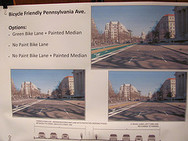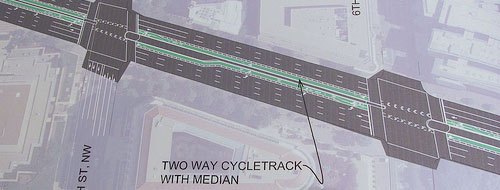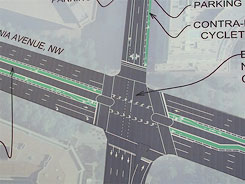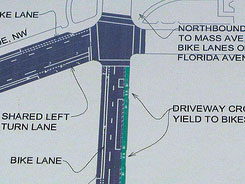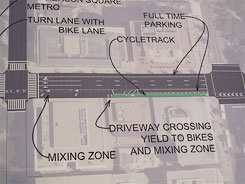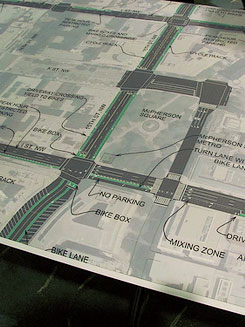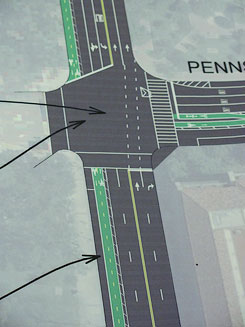DDOT shares downtown bicycle facility plans
Last night, the District Department of Transportation shared its proposals for a network of “innovative” bike facilities in downtown Washington.
DDOT’s proposal calls for new facilities to be constructed this year along Pennsylvania Avenue, 9th, 15th, I, and L Streets. They hope to have Pennsylvania Avenue facility, which has been championed by U.S. Rep. Earl Blumenauer (D-OR), ready for bike commuters on Bike to Work Day in May.
DDOT presented statistics on the effects of the cycle tracks as well, which WashCycle noted. Bicycle ridership generally increases 18-20% when cities add cycletracks, but only 5-7% for bike lanes. New York’s cycletracks also reduced injuries by 56%, crashes by 48%, injuries to pedestrians by 29%, and injuries to cyclists by 57%.
Pennsylvania Avenue
A bidirectional cycletrack would go in the median of Pennsylvania Avenue, between 15th Street at Freedom Plaza to 3rd Street. Cyclists would use the signals for through traffic as their indicators for when it is safe to go. When leaving the cycletrack, they would make a “pedestrian left” by proceeding through the intersection on a green light and stop in the median to wait for the perpendicular walk sign/green light. If turning right, they would stop in the median and wait for the perpendicular walk sign/green light or would work their way right one lane at a time as they approach their turn.
9th Street In addition to a one-way, right-side bike lane flowing with traffic southbound on 9th Street, DDOT would install a one-way contraflow cycle lane (like the one on 15th Street) between Pennsylvania Avenue and Mount Vernon Square. The contraflow cycle lane would be on the east side of 9th Street. I (Eye) Street On I Street, a one-way westbound bike lane would be located on the left side (south side) of the street. It would run from New York Avenue (near 11th Street) to Pennsylvania Avenue (near 21st Street). In some places, the lane would be buffered with stripes or parking, and in other places, cyclists would mix with left-turning motorists. L Street As a complement to the I Street bike lane, a one-way eastbound bike lane would run along the left side (north side) of L Street. It would run from Pennsylvania Avenue (near 24th Street) to Massachusetts Avenue (near 11th Street). Like the I Street lane, it would be a mix of buffered and shared lanes. 15th Street Between I Street at McPherson Square to Massachusetts Avenue, 15th Street would acquire right-side bike lanes in both directions. At the northern end, this would tie in with current bike facilities on 15th Street. The southbound contraflow lane would become a regular cycle lane south of Mass. Ave, and the northbound cycle lane would connect to the existing “sharrow” lane north of Mass. Ave. Cycle facilities would continue south of McPherson Square as bike lanes on Vermont Avenue. Currently, DDOT is not sure how they’ll connect the Vermont Avenue cycle lanes to 15th Street adjacent to the Treasury Building. They may just sign it as a bike route. Between Pennsylvania Avenue (the section in front of the White House) and Constitution Avenue, a bidirectional cycletrack would be located on the west side of 15th Street. Other bike lanes DDOT also plans to add regular right-side cycle lanes along 13th Street between K Street and Massachusetts Avenue and on New York Avenue between 15th Street and Mount Vernon Square. WashCycle points out that one drawback of these designs is the way they vary from block to block, which could be confusing. On the other hand, downtown changes greatly from block to block, so while not ideal, this might be the best way to get cycle tracks built downtown. In an upcoming post, I’ll share a few other concerns and questions that came out of the meeting.
